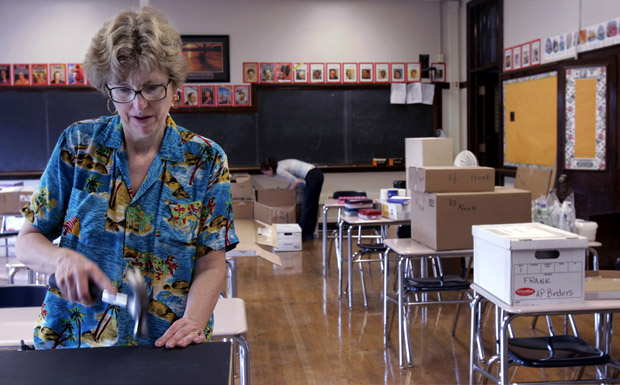100 new Chicago schools in 5 years…again
By Linda Lutton

100 new Chicago schools in 5 years…again
By Linda Lutton
Chicago is planning to continue with its controversial Renaissance 2010 schools strategy, if not in name then in substance.
In a “concept paper” requesting $20 million from the Bill and Melinda Gates Foundation, Chicago Public Schools revealed plans to open 100 schools in the next five years— 60 of them charter schools. “Turnaround and contract schools represent the rest,” the paper says.
The Chicago Tribune first reported on the application to the Gates Foundation Thursday.
Schools spokeswoman Becky Carroll denied the plan is a renewal of the controversial Renaissance 2010 policy begun under former Mayor Richard Daley. That initiative created more than 100 new schools in five years but also sparked bitter school closings and charges that the district was privatizing the school system.
Carroll said the numbers in the document are only “projections,” and are in line with recent charter expansions.
This is the first time Chicago Public Schools has publicly admitted it plans to continue with the same pace of new school creation set under former schools chief Arne Duncan. The decision comes as the system faces a $600 million deficit, and despite enrollment declines that have left one-third of current schools under-enrolled. Adding 100 more schools to a system of declining enrollment could mean a massive number of school closures in coming years, and could substantially increase the percentage of privately run schools in the system.
The proposal to Gates was written by the school district and some of the city’s biggest charter school networks, many favorites of Mayor Rahm Emanuel and CPS, including Chicago International Charter Schools, Noble Street, LEARN, KIPP, and UNO. The proposal was signed by directors of those schools as well as Phyllis Lockett, CEO of New Schools for Chicago; Andrew Broy, president of the Illinois Network of Charter Schools; and schools chief Jean-Claude Brizard.
The preliminary proposal—the actual application won’t be filed until June—asks the Gates Foundation for $20 million to set up a Chicago charter school facilities fund. The money would be used to leverage additional private and philanthropic dollars. Chicago charter schools would then compete for capital funds to buy, build, expand or renovate charter school facilities.
Charter advocates say charters are currently underfunded—the Illinois Network of Charter Schools says Chicago is giving its charters just 75 percent of the money regular CPS students receive. The district has disputed that calculation in the past.
District officials say the new facilities fund will help Chicago attract national charter school networks.
“Access to facilities is a chief barrier to entry for high-performing schools that we would like to see expand and locate in Chicago,” district spokeswoman Robyn Ziegler wrote in an email. She said the facilities fund would “provide high performing charter schools with access to much needed funding to open new facilities to meet the demands of families across the city.” The district says 10,000 children are on waiting lists to get into charter schools here.
In addition, the district’s proposal to Gates indicates the district is planning to pay charter schools more per pupil next school year. Charter schools that are not located on CPS properties currently get $425 per pupil to cover the cost of their lease or debt on their building. That will increase to $750 per pupil next year and $1,000 per pupil in the 2013-14 school year, according to the proposal. The district has not announced those plans locally, though the application says the planned funding increases “have already opened up additional financing opportunities for [charter] schools.”
In the neighborhoods, news that Chicago is planning to add another 100 new schools caused some to worry their schools could be targeted for closure.
“There’s been a lot of concerns from parents, teachers, and students about rumors that CPS wants to take the building over and either create a charter school or a military school. Nobody knows anything,” says Maria Trejo, a staff member at Logan Square Neighborhood Association, which has worked to bring programming to Ames Middle School.
Recently Chicago Public Schools took away one of Ames’ feeder schools; that action will lower enrollment at the middle school. Trejo says teachers fearing they’ll be displaced have begun looking for jobs elsewhere.
Logan Square Neighborhood Association pushed for Ames Middle School to be built in the 1990s. Trejo says the community has secured counselors and a clinic in the school as well as more afterschool activities.
“This is a community school and we want it to stay a community school,” she said.
The district has closed or completely re-staffed more than 100 schools since 2002, either for low enrollment or for chronic poor performance.
A WBEZ analysis from 2011 showed that new schools created under Renaissance 2010 are a mixed bag. Many do not outperform nearby neighborhood schools when compared grade by grade, subject by subject. Data released by the state last November also showed mixed results for charter schools.
Gates Foundation spokeswoman Debbie Robinson said Chicago is competing with just a handful of other districts for more than $40 million total. She said the goal of facility supports is to bolster “facility use proposals that would be good for both the district and the charters. Not favoring a district model over a charter model, but looking at what are the schools on the district side or the charter side that are the highest performing models and then looking at how you scale up and replicate and create more seats under a model like that.”